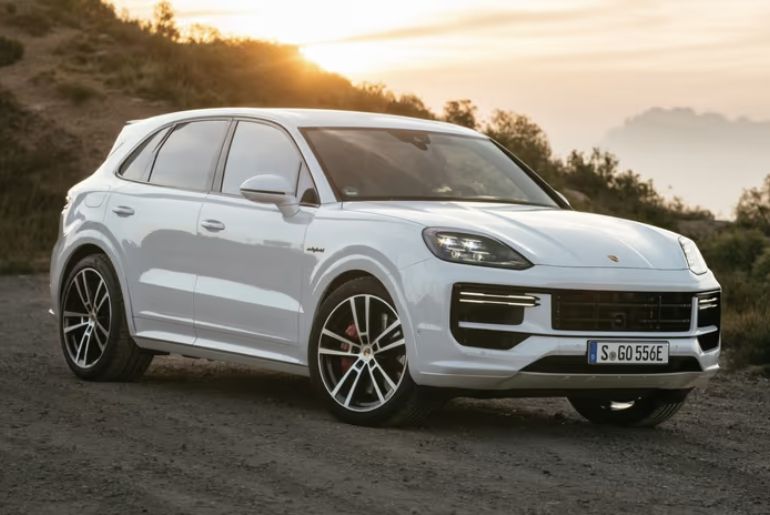Porsche took the Cayenne EV to a hillclimb meet in secret, where it completely broke the previous course record set by a 12-cylinder Bentley Bentayga. Porsche is planning to release the Cayenne EV in the coming year or so.
In the specialised sport of hillclimbing, vehicles begin at the base of a hill and race to the summit. Additionally, electric cars excel in this kind of racing due to their high immediate torque and quick low-end acceleration.
We’ve already discussed a few other hillclimbs, like the well-known Pike’s Peak hillclimb, where electric vehicles broke records the previous year and where Ford will be racing a drastically altered Mach-E this year in a matter of weeks. Because of the high altitude of the event, which causes gas-powered cars to burn inefficiently due to low oxygen levels in the air, EVs perform well here.
In the UK, hill climbing is also quite popular, with routes that are somewhat shorter than the gruelling 12.42-mile “race to the clouds” at Pike’s Peak. Give or take, the majority of courses in the UK are somewhat lengthy.
One of the most well-known in the UK is the Goodwood Hill Climb, where Ford participated (and won) with its absurd 1,400-horsepower electric van, and an electric “fan car” retains the overall course record.
This past weekend’s news occurred at Shelsley Walsh, another track that is a part of the British Hill Climb Championship. The race, which was 1,000 yards (910 m, 0.57 mi) long, was first run in 1905.
It’s only a race, and despite the fact that the Cayenne EV isn’t yet on the market, it completely demolished every other vehicle in its class in that race. Even though a full reveal is anticipated later this year, Porsche nonetheless showed off its capabilities before the release.
In order to break the record set by the Bentley Bentayga W12, an incredibly insane ultra-luxe SUV with a gigantic 12-cylinder, 6-litre twin-turbo engine that can produce 600 horsepower, Porsche brought a prototype of its future EV to Shelsley Walsh.
However, that massive engine was no match for the Cayenne, which broke the old dinosaur-burner’s record by a few seconds.
The Cayenne EV recorded a new mark of 31.28 seconds, surpassing the Bentayga’s 35.53-second record by more than four full seconds. Records on such a short lap are typically set by tenths or hundredths of a second.
For such a big car, the Cayenne has very little body roll and behaves incredibly well throughout the race. This is because of Porsche’s dynamic suspension, the low centre of gravity of many EVs, and the weight of the car being in the battery at the bottom of the vehicle.
Additionally, the Porsche’s immediate acceleration provided it with a sustained edge over the massive Bentayga W12, enabling it to shatter the previous record on such a brief course.
Gabriela Jilkova, Porsche’s Formula E team development driver, piloted the Cayenne EV. It even surpassed the production record for electric cars, which was previously held by the Taycan Turbo, another Porsche. The Cayenne barely beat that record, which stood at 31.43 seconds.
It isn’t the fastest electric car up the hill, though; Mitch Evans set the record in 2018 with a Jaguar Formula E car (from a previous generation; the new Gen 3 EVO cars would undoubtedly be faster).
Since the Porsche Cayenne is still in prototype shape and has not yet undergone homologation, we do not yet have definitive figures on what specifications it will feature. Porsche is still learning like the rest of us, but based on their findings, it appears that they are on to something promising.
There is only one race, and it isn’t a very well-known one. The Cayenne would undoubtedly be outperformed by other vehicles that haven’t climbed this slope. We’re eager to see where Porsche takes this vehicle next and what other petrol SUVs it might be able to disgrace, too, because 4 seconds is a massive record on such a short course and is undoubtedly a shot across the bow.
For a massive vehicle, it also handled incredibly well. Although an SUV is still not a sports vehicle, I didn’t have any concerns while driving it other than the possibility that it was too powerful and that I preferred the 4S because I couldn’t predict when I would need the turbocharged power.
It follows that its larger sibling, the Cayenne EV, would likewise do remarkably well in this situation. Porsche is a master at creating cars and making them work effectively, and they’ve managed to do it with a car as large as the Cayenne EV.
I’m therefore excited for the day when I can bring the Cayenne EV to a Porsche event, just like I did with the Macan, and hear another father ask his youngster, “Want to see the quickest car there? That’s the one. And the documentation will support it.

